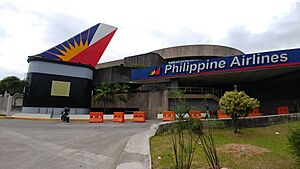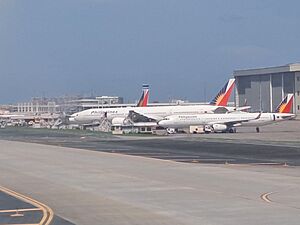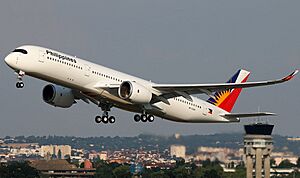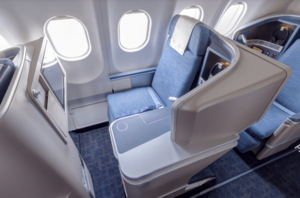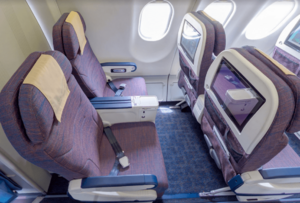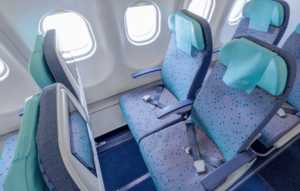Philippine Airlines facts for kids
A Philippine Airlines Boeing 777-300ER
|
|
| Founded | February 26, 1941 (as Philippine Air Lines) |
|---|---|
| Commenced operations | March 15, 1941 |
| AOC # | 2009001 |
| Hubs | Manila |
| Secondary hubs |
|
| Frequent-flyer program | Mabuhay Miles |
| Subsidiaries | PAL Express |
| Fleet size | 48 |
| Destinations | 73 (including PAL Express) |
| Parent company | LT Group (PAL Holdings, Inc.) |
| Headquarters | Lucio K. Tan Jr Center, Andrews Avenue, Pasay, Philippines |
| Key people | |
| Revenue | |
| Operating income | |
| Net income | |
| Total assets | |
| Total equity | |
| Employees | |
Philippine Airlines (PAL) is the main airline of the Philippines. It is often called the country's "flag carrier." The airline started in 1941 and is the oldest airline in Asia that is still flying today.
Philippine Airlines had its first flight on March 15, 1941. It used a small Beechcraft Model 18 plane to fly from Manila to Baguio. After a short break during World War II, the airline started flying again in 1946. It became the first Asian airline to fly across the Pacific Ocean, with a flight from Manila to Oakland, California. PAL grew quickly in the years that followed.
Over the years, PAL has gone through many changes. It has updated its planes, added new routes, and improved its services. In February 2018, a company called Skytrax gave Philippine Airlines a four-star rating for its quality.
The airline's main base for flights is at Ninoy Aquino International Airport in Metro Manila. PAL mostly flies to other countries in Asia, North America, and Oceania. It also has some flights within the Philippines, like to Cebu, Davao, and Iloilo. Most domestic flights are handled by its partner airline, PAL Express.
Contents
History of Philippine Airlines
Philippine Airlines (PAL) began on February 26, 1941. It was first called Philippine Air Lines. A group of business people, including Andrés Soriano, bought the flying rights from another company called the Philippine Aerial Taxi Company (PATCO).
PAL was once one of the biggest airlines in Asia. However, it faced big problems during the 1997 Asian financial crisis. The airline lost a lot of money. To save itself, PAL had to make big changes. It stopped flying to Europe and the Middle East, cut most of its flights within the Philippines, used fewer planes, and had to let go of many employees.
In September 1998, PAL even stopped flying for a short time. It then went into a special process to get its finances in order. Operations started again in October 1998. Over time, PAL brought back many of its flights. The airline successfully recovered in 2007 after fixing its financial plan. Since then, PAL has worked to become a top airline in the Asia-Pacific region again.
How Philippine Airlines Works
Philippine Airlines is owned by a company called PAL Holdings. This company manages all of the airline's operations. PAL Holdings is part of a larger group of companies owned by a famous businessman named Lucio Tan.
Since early 2024, the airline's main office has been at the Lucio K. Tan Jr. Center in Pasay. In 2017, PAL was ranked as the ninth-largest company in the Philippines based on its earnings. As of December 31, 2024, PAL had 6,520 employees working for it.
Financial Information
| Financial performance (PHP billions) | |||||||||||||||||
|---|---|---|---|---|---|---|---|---|---|---|---|---|---|---|---|---|---|
| Fiscal year | 2014 | 2015 | 2016 | 2017 | 2018 | 2019 | 2020 | 2021 | 2022 | 2023 | 2024 | ||||||
| Revenue | 100.9 | 107.2 | 114.5 | 129.5 | 150.5 | 154.5 | 55.3 | 58.7 | 139.2 | 179.1 | 178.0 | ||||||
| Expenses | 98.6 | 98.4 | 104.8 | 132.2 | 156.5 | 151.7 | 81.8 | 62.8 | 121.9 | 151.0 | 160.0 | ||||||
| Income before tax | 0.3 | 6.7 | 7.1 | −6.5 | −7.4 | −11.2 | −65.9 | 53.7 | 10.6 | 21.8 | 9.4 | ||||||
| Net income | 0.1 | 6.7 | 4.9 | −6.5 | −3.7 | −9.7 | −73.1 | 60.6 | 10.4 | 21.3 | 8.1 | ||||||
| Assets | 109.2 | 114.4 | 125.3 | 179.9 | 199.1 | 317.8 | 227.9 | 193.8 | 206.0 | 219.7 | 213.3 | ||||||
| Liabilities | 105.5 | 104.3 | 111.2 | 166.0 | 188.4 | 312.9 | 296.0 | 192.2 | 194.2 | 186.4 | 170.4 | ||||||
| Equity | 3.7 | 10.1 | 14.1 | 13.9 | 10.7 | 4.9 | −68.1 | 1.6 | 11.8 | 33.3 | 42.9 | ||||||
| Operating highlights | |||||||||||||||||
| Fiscal year | 2015 | 2016 | 2017 | 2018 | 2019 | 2020 | 2021 | 2022 | 2023 | 2024 | |||||||
| Passengers (million) | 11.9 | 13.3 | 14.5 | 15.9 | 16.7 | 3.9 | 2.9 | 9.3 | 14.7 | 15.6 | |||||||
| Available seats (million) | 17.5 | 19.2 | 20.3 | 20.5 | 21.8 | 6.8 | 6.8 | 12.9 | 18.1 | 19.7 | |||||||
| Load factor (%) | 68.3 | 69.2 | 71.4 | 77.4 | 76.5 | 56.7 | 42.6 | 72.0 | 81.0 | 79.1 | |||||||
| RPK (million) | 28,301 | 32,503 | 36,973 | 40,003 | 42,329 | 11,873 | 7,680 | 24,860 | 35,338 | 35,377 | |||||||
| ASK (million) | 41,439 | 46,996 | 51,793 | 51,682 | 55,308 | 20,918 | 18,023 | 34,538 | 43,734 | 44,737 | |||||||
Note
- Data before 2014 were not included in the table because they used a different way of counting.
Where Philippine Airlines Flies
In 1980, Philippine Airlines flew to many cities in Europe, like Amsterdam, Frankfurt, and London–Gatwick. After the 1997 Asian financial crisis, PAL stopped many of its long flights.
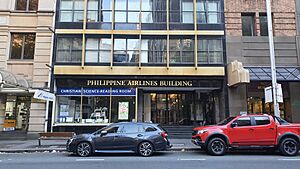
In 2010, the European Union (EU) stopped all airlines from the Philippines from flying to Europe because of safety worries. But in 2013, the ban was lifted, and Philippine Airlines could fly to Europe again. That same year, PAL started flying to London–Heathrow again. On October 29, 2018, the airline started non-stop flights to New York–JFK. This was one of the longest commercial flights in the world at that time.
As of 2025, Philippine Airlines flies to 41 international places and 32 places within the Philippines. Its partner airline, PAL Express, handles most of the flights within the country.
Partner Airlines
Philippine Airlines works with other airlines so passengers can connect to more places. This is called a codeshare agreement. PAL shares flights with these airlines:
- Air Macau
- Alaska Airlines
- All Nippon Airways
- American Airlines
- Bangkok Airways
- Cathay Pacific
- China Airlines
- Garuda Indonesia
- Gulf Air
- Hawaiian Airlines
- Malaysia Airlines
- Qatar Airways
- Royal Brunei Airlines
- Saudia
- Singapore Airlines
- Turkish Airlines
- Vietnam Airlines
- WestJet
- XiamenAir
Philippine Airlines Fleet
As of May 2024, Philippine Airlines has 49 planes in its main fleet. This does not include the 28 planes used by PAL Express. The fleet includes different types of planes from Airbus and Boeing, including both smaller narrow-body and larger wide-body aircraft.
Philippine Airlines Branding
Logo History
The Philippine Airlines logo has changed four times since the airline started.
- First Logo (1950s-1960s): It had a blue oval with "PAL" in white letters. There was also a four-pointed star and a wing.
- Second Logo (Mid-1960s-Mid-1970s): This logo used a blue triangle and a red triangle inside a circle. It looked like the Philippine flag.
- Third Logo (Mid-1970s-1986): This was a simpler version of the second logo, without the circle.
- Current Logo (Since 1986): This logo still uses the blue and red triangles. It also has an eight-pointed yellow sunburst on the blue triangle. The words "Philippine Airlines" use a new, modern font.
Plane Colors and Design (Livery)
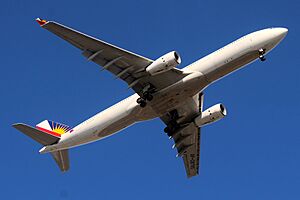
PAL planes have had many different looks. The first planes were simple, with a white top and silver bottom, and a small Philippine flag on the tail.
The current design, called "Eurowhite," started in 1986. It has the word "Philippines" written in italics on the front of the plane. The tail has the PAL logo, and the Philippine flag is near the back of the plane. The word "Philippines" is used instead of "Philippine Airlines" to show that PAL is the main airline of the country.
Sometimes, when the President or Vice President travels, a PAL plane is used. If a PAL plane has the flight number "PR/PAL 001" and the callsign "PHILIPPINE ONE," it means the President is on board. If the Vice President travels at the same time, the flight number is "PR/PAL 002" and the callsign is "PHILIPPINE TWO." The presidential seal is also placed near the doors of the plane when the President is using it.
For its 70th anniversary in 2011, PAL put a special sticker on its planes that said "Asia's first, shining through." For its 75th anniversary in 2016, another special sticker was added. PAL also put a "4-star Skytrax" sticker on its planes to show its new rating.
In February 2019, Philippine Airlines showed off its fifth Airbus A350 plane with a "LoveBus" sticker. This celebrated 40 years of working with Airbus and showed the airline's caring service. The original "LoveBus" logo was on an Airbus A300 in 1979. The new LoveBus A350 was ready on Valentine's Day, February 14, 2019.
Mabuhay Miles Program
Mabuhay Miles is Philippine Airlines' program for frequent flyers. It started in 2002. Passengers earn points when they fly, and these points can be used for free flights or other benefits. There are different levels: Classic, Elite, Premiere Elite, and Million Miler.
Banks like Philippine National Bank (PNB) offer special credit cards with Mabuhay Miles. These cards give benefits like free points, travel insurance, faster check-in, and access to special airport lounges.
Mabuhay Lounge
The Mabuhay Lounge is a special waiting area at the airport for Philippine Airlines passengers. Business Class passengers and Elite Members of Mabuhay Miles can use these lounges. They offer free drinks, food, Wi-Fi, and charging spots for phones and other devices.
As of September 2023, Mabuhay Lounges can be found at several airports, including Ninoy Aquino International Airport in Manila, Mactan–Cebu International Airport, and San Francisco International Airport.
What's Inside the Plane
Cabin Classes
Philippine Airlines offers three types of seating: Business Class, Premium Economy, and Economy Class. The type of seating available depends on the plane. Some planes, like the Airbus A330s and Airbus A350s, have all three classes. Other planes have two classes. In September 2022, PAL renamed its Premium Economy service for flights within the Philippines to "Comfort Class."
In 2017, PAL updated eight of its Airbus A330 planes. They changed them from having only one class with 414 seats to having three classes with 309 seats (Business, Premium Economy, and Economy). These updated planes also got new entertainment systems.
Older planes did not have built-in screens for entertainment, except for the Boeing 777-300ERs. Instead, they offered iPads with movies and shows. Newer planes now have screens built into the seats.
Business Class
Business Class is available on all PAL planes. These seats offer more legroom and can even lie flat on some planes, like the Airbus A330, Boeing 777, Airbus A350, and some Airbus A321neo planes. Philippine Airlines is the only airline in the Philippines that offers Business Class on flights within the country. On longer flights, passengers get special kits with toiletries.
The seats on the Airbus A330 and Airbus A350 can lie completely flat. They also have large screens (18.5 inches) for movies and shows, a USB port to charge devices, and noise-cancelling headphones.
Premium Economy (Comfort Class)
Premium Economy (called Comfort Class for domestic flights) is on the Airbus A330 and Airbus A350 planes. It's also on some PAL Express flights using Airbus A320s. These seats are like regular Economy seats but have more legroom, usually 34 to 36 inches.
On the updated A330s and A350s, these seats have extra padding and a 13.3-inch screen for entertainment. They also have a USB port and power outlet. On planes without built-in screens, passengers get free iPads.
Economy Class
Economy Class is available on all PAL planes. Each seat has a tray table on the back of the seat in front. The seats have headrests that can be adjusted. They offer 31 to 34 inches of legroom.
Each seat has a screen (9 or 10 inches) for movies and shows, a headphone jack, and a USB port for charging devices. The seats can recline about six inches.
Safety and Issues
Safety Record
Philippine Airlines planes have been in some accidents since 1941, but most of these happened with older propeller planes in the early years. Few PAL jet planes have been involved in serious accidents.
In February 2007, PAL was the first airline in the Philippines to pass a special safety check by the International Air Transport Association. AirlineRatings.com gives Philippine Airlines a high safety rating of 7 out of 7.
Financial Challenges
PAL faced big financial problems in the late 2000s. The airline's money and property decreased a lot between 2006 and 2013. This was partly because of lower value of its planes and equipment. Even though PAL carried more passengers in 2009, its costs went up because of more flights and higher fuel prices.
Employee Relations
PAL has had some disagreements with its employees in the past. In 1998, PAL had to let go of about 5,000 employees, including many flight attendants, to save money during a tough time for airlines. The employees took the airline to court, saying it was unfair. After many years, the court decided in favor of the employees in 2008, saying PAL did not prove it was truly bankrupt. However, in 2018, the Supreme Court later sided with Philippine Airlines regarding how it chose which employees to let go.
Competition
For over 20 years, PAL was the only major airline in the Philippines. But in 1995, new rules allowed other airlines to start flying. This brought more competition, which led to lower ticket prices and better service for passengers. Today, PAL competes with other airlines like Cebu Pacific and PAL Express on many flights. Other airlines like Philippines AirAsia and Cebgo serve shorter routes.
See also
 In Spanish: Philippine Airlines para niños
In Spanish: Philippine Airlines para niños
- List of airlines of the Philippines
- List of companies of the Philippines
- Transportation in the Philippines


